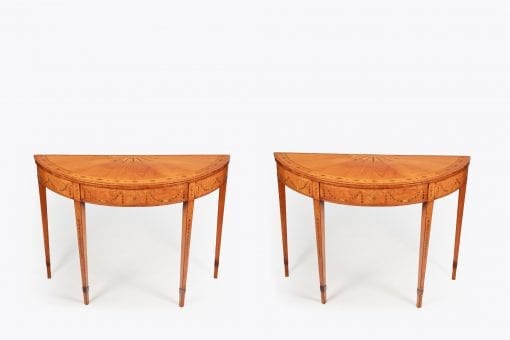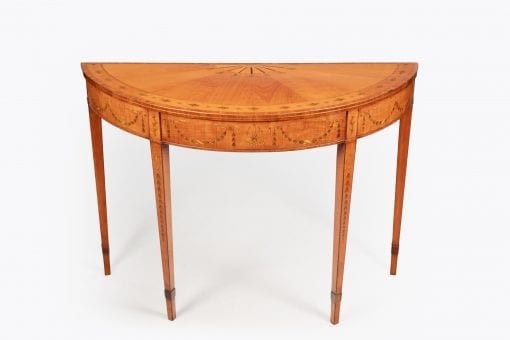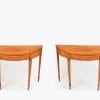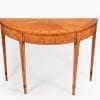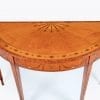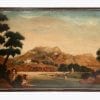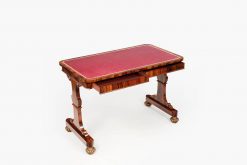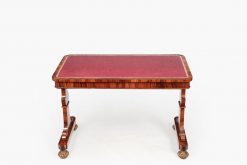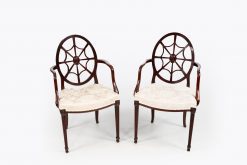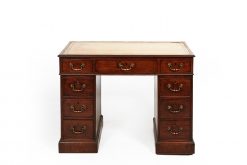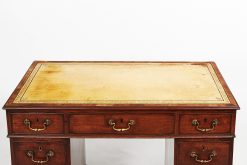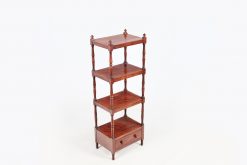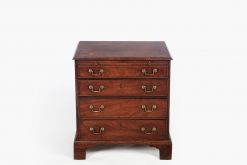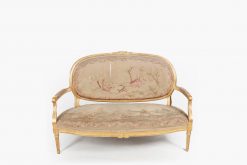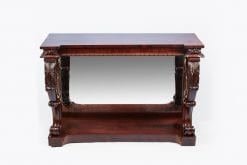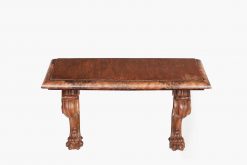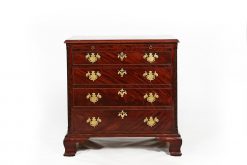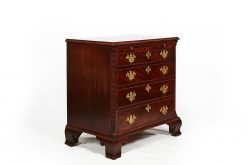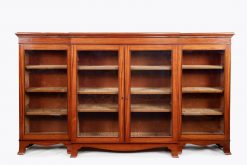Whilst associated with Ireland, William Moore (d.1815) was a London cabinet maker who served his apprenticeship with the celebrated London firm of Ince and Mayhew where he specialised as a ‘marqueteur’ prior to the establishment of his own firm in Dublin in 1782. Ince and Mayhew’s work from the late 1760s was increasingly in the emerging neo-Classical manner which was filtering through to Britain from France through the published works of such architects as Delafosse and Gilles-Marie Oppenord. Although it was not unitl the publication of Robert and James Adam’s Works in Architecture in 1773 (featuring Robert Adam’s neo-Classical interiors at Kenwood, 1768-71 and Osterley Park, 1767-80) that the transition was completed. Ince and Mayhew were best known for their skilled and innovative use of marquetry and were able to put themselves at the vanguard of the new fashion and its is within this enviroment that Moore’s work must be considered. Their earliest known commode decorated solely with marquetry dates from as early as 1764 and they were also the first to produce semi-elliptical commodes through their involvement with the Countess of Derby’s Etruscan commodes for which they were employed by Adam in 1774. Ince and Mayhew’s mature neo-Classical marquetry depended upon a vocabulary of large scale motifs, such as urns, tripods and swags ‘coloured and boldly inlaid upon contrasting fields (and) subtle foliage inlaid in different woods’, often fruit woods such as pear, holly, plum and harewood. A style reflected in Moore’s work.
Moore’s apprenticeship with Ince and Mayhew provided him not only with the finest skill as a cabinetmaker and marquetry specialist but also with an education in contemporary taste and design that enabled him to set up on his own in 1782. Keen to open his own firm and with the high end of the London market saturated with firms such as Thomas Chippendale, John Cobb, John Linnell and of course, Ince and Mayhew. Moore moved to Dublin and this proved to be well timed and profitable due to the birth of Dublin’s Georgian New Town and the massive increase in demand for fashionable cabinet makers. A situation closely comparable to that in Edinburgh and the sudden success of cabinet makers such as William Trotter. Moore’s first known premises were in Abbey Street, 1785-90 and subsequently larger premises in Capel Street, where he remained until his death in 1815. Moore advertised his new business in the Dublin Post in 1782 in which he specifically refers to his new expertise with inlay and his training under Ince and Mayhew:
‘William Moore most respectfully acknowledges the encouragement he has received, begs leave to inform those who may want Inlaid work, that by his close attention to business and instructions to his men, he has brought the manufacture to such perfection, to be able to sell for almost one half his original prices; as the greatest demand is for Pier Tables, he has just finished in the newest taste a great variety of patterns, sizes and prices, from three guineas to twenty; Card tables on a new construction (both ornamented and plain) which appear like small Pier Tables, with every article in the inlaid Way, executed on shortest notice, and hopes from his long experience at Messrs. Mayhew and Ince, London, his remarkable fine coloured woods, and elegant finished work, to meet the approbation of all who shall please to honour him with their commands’.
The Victoria and Albert Museum’s collection of works by Moore includes a harewood commode with scalloped central fan and ribbon marquetry to the top. The collection also comprises a pair of commodes and side table from Lismore Castle, Waterford. Whilst other known works by Moore include a commode at Welbeck Abbey, commissioned for the Duke of Portland’s arrival in Dublin as the new Viceroy of Ireland in 1782, the same year Moore himself arrived in the city.
The inlaid fan decoration and radiating veneer to the top are typical of Moore’s work. The plain veneered grounds of the oval fields reflect the rising influence of Henry Holland during the 1780s, who popularised the French trend away from inlaid designs towards well chosen, plain mahogany and rosewood veneers. This makes it seem likely that this commode would date from the mid to late 1780s and further suggests that Moore was moving away from the intricate marquetry style he had perfected while with Ince and Mayhew.

